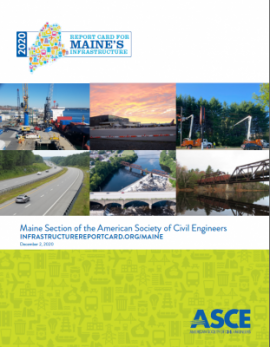Bridges
Keep the Work Off the Road
Kittery, ME

Civil engineering is a broad field dealing with the planning, design, construction, maintenance and management of infrastructure networks and the resulting safety of the public. Every four years, the Maine Section of the American Society of Civil Engineers (ASCE) provides a comprehensive assessment which results in the Report Card for Maine’s Infrastructure. Using publicly available data and the expertise of industry experts, the Report Card analyzes the current condition and needs to assign a simple A to F letter grade to 16 infrastructure categories. The maintenance and improvement of Maine’s infrastructure is vital to our economy, health, safety, security, and the environment. Decisions about infrastructure the public uses, which we all pay for through user fees and taxes, as well as private investments, need to be made based on long-term comprehensive planning, with sustainable and reliable funding sources.
The purpose of the Report Card on Maine’s Infrastructure is to raise public awareness of the importance of modern and well-maintained infrastructure. Maine’s infrastructure cannot be taken for granted and requires on-going maintenance and continuous planning. We believe discussion of the issues detailed in this Report Card will lead to a greater understanding of the current and future needs of our state, prompting decision makers in our communities, the state legislature, and our congressional delegation to formulate policies and provide the necessary funding to address our infrastructure needs.
To read about how each category of infrastructure scored, keep scrolling or read the Report Card for Maine’s Infrastructure Executive Summary.
Maine’s airports have made notable improvements since 2016, reaching a state of good condition and are poised to remain safe, reliable, and sufficient to serve the state’s future needs. While the two largest airports, Portland International Jetport and Bangor International, have some minor capacity restraints, system-wide, Maine’s airports do not have notable air or landside shortfalls. The state’s Airport Improvement Program has an average of 41% higher funding since 2017, resulting in more resources for significant pavement, safety, and capacity improvements. However, threatening a future fiscal gap is the $4.50 cap on the Passenger Facility Charge (PFC) which must be eliminated to provide a more sustainable source of funds for airport improvements.
Maine’s highway system includes a total of 3,754 bridges, 58% of which are more than 50 years old. Historic funding levels have not been sufficient to replace bridges before they exceed their expected design life and nearly one out of every seven Maine bridges (13%) is structurally deficient. Accordingly, MaineDOT’s current 3-year work plan includes a continued emphasis on bridge maintenance and preservation projects. The number of structurally deficient bridges in Maine has been improving gradually over the past several years. While public support for transportation spending in Maine remains strong, achieving and sustaining long-term improvements requires a comprehensive strategy to address the $68 million shortfall in annual funding needed for Maine bridges.
The Maine Dam Safety Program (MDSP) has identified 1,073 dams in Maine that have an average age of 104 years; additional dams exist but are not registered. 148 of Maine’s registered dams are classified as significant- and high-hazard potential dams, meaning failure would result in considerable damage and/or loss of life. Nearly 100% of such dams have emergency actions plans, exceeding the national average of 81%. Maintaining and improving Maine’s dams continues to be limited by funding; the MDSP receives less funding than the national average and other New England states, limiting the capacity of the program. Available loan programs are under-utilized and grant opportunities are insufficient to address the nearly $269 million investment needed to adequately maintain Maine’s dam infrastructure.
An estimated two-thirds of Maine residents are served by 158 public drinking water systems. Aging water mains continue to be a serious issue as utilities miss the 1% annual replacement rate, effectively adding 10-50 years to the existing 100-year replacement cycle. This is largely due to project funding needs exceeding the resources available at federal and state-levels. The Drinking Water Program estimates $59 million per year is needed over the next 20 years for drinking water infrastructure projects which equates to an annual $31 million shortfall in funding need. Presently 45% of applicants, including many disadvantaged systems, are still unable to access competitive state funds.
Much of the electricity infrastructure in the state was built between 1970 and 1990, meaning the original transmission and distribution network has begun to reach its useful service life. Meanwhile, some of Maine’s electricity outage, interruption, and customer satisfaction indexes have declined in recent years. However, Maine, a renewable energy leader in the region and the United States, is on pace to meet its updated Renewable Portfolio Standards. Recent major improvements in Maine’s bulk electric transmission system and plans to upgrade and harden the distribution system are building a more reliable and resilient network. Additional improvements in excess of $1 billion annually are needed to achieve Renewable Portfolio Standards and to improve system reliability and resilience.
Funding has increased for the Brownfields assessment and cleanup assistance programs; however, available funds are insufficient to cover all sites. Additional challenges include addressing emerging contaminants and climate resiliency. The Maine Department of Environmental Protection’s (DEP) remediation site database includes 859 sites as “active” with 263 sites listed as awaiting resources. This is an increase from 2016 which had 693 active sites with 155 awaiting resources. Many of these sites have entered the system through the Voluntary Response Action Program (VRAP) and Brownfields programs, indicative of an increase in cleanup and redevelopment projects. Though this is positive, the limited options for reuse of excess soil from these projects creates a significant impediment.
The National Levee Database identifies five levees in Maine that protect 600 citizens and $133 million of property from flooding. In 2013, U.S. Army Corps of Engineers (USACE) assessed four of the five levees to be “minimally acceptable” and one levee “unacceptable”. While the USACE considers the risk associated with Maine’s five levees to be “low” in comparison to levees nationwide, breaches of these levees may be catastrophic to the communities they protect and therefore justify increased investment to manage this risk. However, funding for the maintenance and improvement of Maine’s levees is generally limited to local contributions which are often insufficient to properly maintain the levees. Federal funding is available for the upgrade of levees but has historically been competitive or required local funding matches beyond the capacity of local communities.
Maine’s state parks are a key contributor to tourism which is one of Maine’s top industries. Outdoor recreation generates $8.2 billion in annual consumer spending and supports over 75,000 jobs. Attendance at Maine’s state parks has continued to rise in recent years. However, there has been little capital investment to help reduce an estimated $50 million maintenance backlog. The Maine Department of Agriculture, Conservation, and Forestry continues to prioritize the use of available funding based on the most critical needs and managing deferred maintenance needs to the extent practicable. While some improvements have been made, the needs continue to outweigh the funding available. If this trend continues, visitor experiences will diminish in quality and Maine may suffer lost economic opportunities.
Maine’s ports are in good condition with more than $108 million in state and federal funds invested over the last 12 years. Projected growth in freight traffic and the cruise industry will require an additional $110 million for necessary investments in areas of industrial infrastructure, intermodal connections, cruise ship terminals, and municipal facilities. Maine has not yet fully leveraged the opportunities afforded by the M-95 Marine Highway and short sea shipping and investments are needed to make this shipping option viable. Cruise ship calls throughout the state have been historically strong with year over year increases, except in 2020. Maine should update its Three Port Strategy to reflect recent investments to its industrial terminals.
Maine has 1,296 miles of active railroad with the pulp and paper and lumber industries as the largest rail customers. Recent federal grants have been leveraged with state and private funding to make noticeable improvements to Maine’s railroads over the past four years. At the completion of the planned improvements in the near future, it is expected that all of the state’s railroad main lines will be able to support 286,000-pound rail cars, the standard with Class I railroads, a major modernization milestone. Meanwhile, a $20 million federal grant aided in track updates that now allow for increased speed and reliability. However, one area of concern is the unimproved condition of state-owned railroad tracks rated good or fair which remained at 56.4%, the same as in 2016.
There are nearly 23,000 miles of roads in our rural state, and MaineDOT manages 37% of them. The state’s highway system had a projected $165 million annual funding gap before the drastic downturn in 2020 which will grow the need even more. Due to Maine’s continued funding shortfall, roads are not meeting the customer condition, safety, and service goals; with 8% of the highest priority roads continuing to have low ratings in condition and safety. Maine motorists spend at least an extra $1 billion per year in vehicle operating costs, congestion, and crashes with the state producing the highest fatality rate in New England. However, recent leadership in the state legislature and years of overwhelming voter support at the ballot box for transportation bond referendums points to interest in finding sustainable funding solutions for Maine’s roads.
Approximately 170,000 pupils attend school at Maine’s 540 school facilities. Maine school districts spend only 1-2% of their operational budgets on infrastructure maintenance and repairs. Since 2010, 16 new schools were built and 30 deficient facilities were closed through the two primary state programs providing funding for infrastructure – the Major Capital Projects program and the School Revolving Renovation Fund. Current funding levels show an estimated gap of $2.8 billion in major renovations or new construction between the requested and funded projects. However, after five years of funding well below the allowable debt ceiling, the last four years have increased funding up to the debt ceiling and also additional funding has been added to the revolving fund for smaller projects.
In 2017, Mainers generated and disposed of 1.4 million tons of municipal solid waste (MSW), including construction and demolition debris (CDD), which is an average of 1,080 pounds of household waste per person, a reduction from the 2013 rate of 1,140 lbs/person and consistent with the national average of 1,068 lbs/person. At 38% in 2017, MSW recycling remains below the state-established goal of 50%. Strict solid waste regulations are in place to limit environmental impacts. Landfill capacity continues to be efficiently utilized through volume reduction efforts at Waste-To-Energy (WTE) facilities. However, legislation is needed to further limit out-of-state waste. Continued promotion of reduction and reuse, along with planning and investment will be necessary to ensure waste minimization is achieved and disposal capacity is available beyond 20 years.
Thirty communities with municipal separate stormwater sewer systems (MS4) have 45% of the state’s urban population and 30% of the state’s developed land. Capacity and condition of the MS4s have not been assessed comprehensively; rather attention has been focused on the combined sewer infrastructure to minimize the sewage overflows entering the state’s waters. Within the past five decades, extreme precipitation events increased by 70% which is more significant than in any other U.S. region. Urban stormwater disproportionately impacts Maine’s surface water quality considering that only 2.8% of the state is developed land. Dedicated funding for stormwater infrastructure is critical; voter-approved bonds similar to the transportation sector and more local stormwater utilities are crucial for serving the present needs while preparing for the future.
Maine has 23 transit systems that receive state or federal funding. Most areas in Maine do not have the population density to support typical transit services, but between 2013 and 2017 ridership in southern Maine has increased 13%, by more than half a million riders, counter to national trends. As Maine’s population continues to age, and to improve sustainability into the future, transportation options will become increasingly important. However, the state only provides 86 cents annually per capita as an operational subsidy for transit services, much less than other New England states and 38th in the nation. In 2019, underfunding results in the fleet of 436 transit vehicles with 36% classified in good condition while more than 50% were fair or poor. An infusion of federal funds through CARES Act in 2020 should lessen the impact on operators during the current downturn in usage.
Maine faces challenges with aging municipal wastewater infrastructure including collection systems and treatment facilities. While many treatment plants were originally built in the 1970s and have not undergone significant upgrades, targeted improvements have reduced the volume of combined sewage and stormwater discharges from 6.2 billion gallons in 1987 to 0.5 billion gallons in 2018. However, funding needs are expected to increase as coastal water districts begin to prepare for or respond to the impacts of climate change. Marked with progress, Maine still lacks updated statewide assessment data for understanding the funding needs for the state’s wastewater infrastructure.
A: EXCEPTIONAL, B: GOOD, C: MEDIOCRE, D: POOR, F: FAILING
Each category was evaluated on the basis of capacity, condition, funding, future need, operation and maintenance, public safety, resilience, and innovation

Aviation
4 major airports

Drinking Water
$2.0 billion total drinking water need

Transit
3.9 million passenger trips across 24 systems in 2021

Bridges
2,485 bridges, 12.6% of which were structurally deficient in 2021

Hazardous Waste
16 Superfund sites

Wastewater
$970 million total wastewater need

Dams
73 high hazard dams

Levees
2 miles of levees protect 427 residents

Roads
44% of roads are in poor or fair condition
Smart investment will only be possible with strong leadership, decisive action, and a clear vision for our nation’s infrastructure.
If the United States is serious about achieving an infrastructure system fit for the future some specific steps must be taken, beginning with increased, long-term, consistent investment.
We must utilize new approaches, materials, and technologies to ensure our infrastructure can withstand or quickly recover from natural or man-made hazards.

Civil Engineers Give Maine’s Infrastructure a “C-” in 2020 Report Card
December 03, 2020
Maine civil engineers gave 16 categories of infrastructure a cumulative grade of a “C-,” meaning the state’s systems are just below mediocre condition. Civil engineers...
 Link to Post:https://infrastructurereportcard.org/asce-testifies-in-support-of-infrastructure-investment/">ASCE Testifies in Support of Infrastructure Investment
Link to Post:https://infrastructurereportcard.org/asce-testifies-in-support-of-infrastructure-investment/">ASCE Testifies in Support of Infrastructure InvestmentASCE Testifies in Support of Infrastructure Investment
February 28, 2020
On February 27, Lynn Frazier, P.E., A.M.ASCE, testified on behalf of ASCE before the House Small Business Subcommittee on Contracting and Infrastructure about the state...
 Link to Post:https://infrastructurereportcard.org/new-report-affirms-higher-gas-tax-is-needed-to-restore-our-interstates/">New Report Affirms Higher Gas Tax is Needed to Restore Our Interstates
Link to Post:https://infrastructurereportcard.org/new-report-affirms-higher-gas-tax-is-needed-to-restore-our-interstates/">New Report Affirms Higher Gas Tax is Needed to Restore Our InterstatesNew Report Affirms Higher Gas Tax is Needed to Restore Our Interstates
December 07, 2018
On Thursday, December 6, the National Academies of Sciences, Engineering, and Medicine, Committee for a Study of the Future Interstate Highway System, and the Transportation...